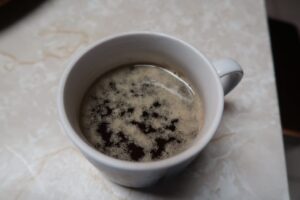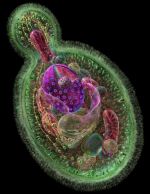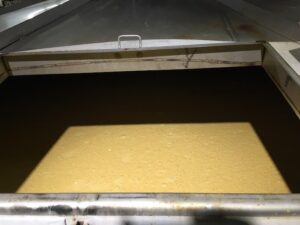Preping for Yeast
Jim Beam Fermenting
Preping for Yeast
Cool mash down to 80 F (65F is most efficient) … you can add cold water and/or ice to speed cooling the mash if diluting is desired. Cool the mash as quickly as you can. Immerse bags of ice to help cool. By cooling the mash quickly, bacteria, yeast etc. which is all around us cannot get started in the batch.
How Much Alcohol? Check Specific Gravity Before Pitching Yeast
This reading will tell you your expected alcohol after fermentation. Use a refractor. This O.G. (original gravity) must be done at this stage in order to subtract the F.G. (final gravity) after fermentation. This product number gravity will tell you what the ABV is before distillation.
Check the PH Before Pitching Yeast
The PH of the liquid after enzymes added shoud be at 5.2. Add lemon juice (acidic) to decrease it, add baking soda (alkaline) to increase it.
Yeast the Fermenter——————–
There are two main factors in producing aroma and taste. Yeast is one…. the other is the main dominant ingredient used, such as wheat, rye, etc.
When buying a desired strain of yeast look for urea free yeast. This adds a cleaner taste but more importantly there is no ethal cabomate produced which is a carcinogen.
Aerate: Oxygen Needs to be Added FIRST, before Yeast Added
Yeast needs oxygen to reproduce and form it’s yeast colony that will convert sugars to alcohol. Oxygen is an essential ingredient right at the start of fermentation to enable the yeast to multiply, called budding. This is the lag phase of fermenting.


Use a fish bubbler with micro holes in a stone to introduce oxygen throughout the liquid. Move the stone around for 5 to 10 minutes. An alternate method not as efficient, is pouring the liquid several times from one bucket to another in a slow stream with a waterfall like appearance.
Do not blow through a tube into the mash to aerate it. That is carbon dioxide not oxygen! Plus you will be introducing bacteria.
Lag Period – Oxygen Needed!
Aerobic phase: Oxygen throughout the mash is essential right at the start of fermentation to enable the yeast to multiply, called budding. This is the lag phase of distilling. But a continuous supply of oxygen will produce a vat of nothing but yeast and no alcohol. The yeast uses some of the sugars to reproduce. The reproduction is rapid. Most reproduction is finished 4 to 6 hours and no longer than 12 hours. Reproduction stops at 50 million cells per milliliter. Oxygen is your friend in the first lag period.
Aerate a mash with oxygen from a bubbler pump. This infuses oxygen for the yeast to use. There is already oxygen in the mash but this assures there is plenty.
Next – NO Oxygen Please
Anaerobic phase: Once the oxygen is gone reproduction stops and the production of alcohol begins. When the yeast makes alcohols it does it by anaerobic fermentation. This means an oxygen starved environment.
The yeast gives off carbon dioxide in the fermentation process. The mash needs to be enclosed so that no oxygen can get to the liquid. Any oxygen in the mash not used by the yeast will exit when the cabon dioxide exits. Any remaining oxygen in the mix will be carried away by the CO2 bubbles.
Any oxygen introduced after fermentation begins will oxidize and leave a stale taste in the mix — a ruined batch! Oxygen is your enemy after the lag period.
Yeast Stress
When conditions are not ideal for a strain of yeast it becomes stressed, producing foul smelling non-flavorful non-healthy byproducts and even stopping the fermentation before converting all the starches.
Another stress on yeast is alcohol. Yeast dies in a dense alcohol solution. However while they are producing alcohol they develop a tolerance for it up to a point, then they will die or go dormant. An alcohol percentage solution that will normally kill yeast will not kill them when they are producing and developing a tolerance.
Ideal Temp for Yeast
Yeast is sensitive to temperature they live in. In a cold environment the production slows and the yeast will even die if colder than their threshold. Warmer environment than the yeast likes and they produce faster but also produce unwanted oils. Keep yeast close to their desired perfect temperature of 65 deg.
Yeast Death
All the yeast dies off or goes dormant when there are no sugars left to consume. At the end of fermentation the bad or fusil oils are a thin layer on the very top. Ethanol alcohol is floating right under the lighter fusil oils since it also is a light fluid but in a much greater quantity. There is a middle layer where a smaller amount of ethanol is mixing with the mash. The other heavier fluids and materials are on the bottom. The dead yeast is the heaviest of the all the particles and falls to the very bottom when it dies. Yeast has a reproductive cycle where it dies after making 17 to 22 daughter yeast cells. Yeast has a reproductive life and a chronological life.
Pre-Proofing Yeast
Use 4 to 8 oz coffee cup or a mason jar .. to create a starter environment. Yeast “learns” to feed on sugars when it wakes up from that little packet you bought – it takes yeast seven generations to learn how to digest a different kind of sugar, so take your starter liquid from the wash batch. Get this yeast colony started while the mash or wash is cooling down. Let it produce a nice foam to demonstrate it is producing many daughter yeast cells.

Take initial gravity reading.
Add yeast nutrient = Diammonium Phosphate, Fermax brand nutrient
74 F to start … will rise slightly as fermentation is in process
OVER-UNDER PITCHING
If you “over-pitch” your yeast- just make sure you have a LOT of copper to get rid of the extra sulfur compounds.
Under pitching causes a long lag time that can allow other bacterial infection to take hold in the mash.


